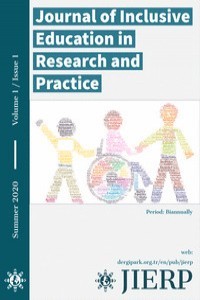Amerika Birleşik Devletleri'nde Kapsayıcı Eğitim: Algı, Politika ve Yapıya Bir Bakış
Kapsama, Göçmenler, Amerika, Engeli olan çocuklar
Inclusive Education in the United States of America: A Glimpse into Perceptions, Policy, and Structure
Inclusion, Immigrants, United States, Students with Disabilities,
___
- ADL (2020) Fighting hate for good. Retrieved on June 20, 2020 from https://www.adl.org/education/resources/tools-and-strategies/table-talk/what-is-daca-and-who-are-the-dreamers May 19, 2020.
- Ainscow, M. (2020). Promoting inclusion and equity in education: lessons from international experiences. Nordic Journal of Studies in Educational Policy, 6(1), 7-16.
- Bajaj, M., Canlas, M., & Argenal, A. (2017). Between rights and realities: Human rights education for immigrant and refugee youth in an urban public high school. Anthropology & Education Quarterly, 48(2), 124-140.
- Barnes, R. (2020, June 18). Supreme court blocks Trump’s bid to end DACA, a win for undocumented ‘dreamers’. The Washington Post. Retrieved from https://www.washingtonpost.com/politics/courts_law/supreme-court-rules-against-trump-administration-attempt-to-end-daca-a-win-for-undocumented-immigrants-brought-to-us-as-children/2020/06/18/4f0b6c74-b163-11ea-8758-bfd1d045525a_story.html
- Brophy, J. (1982). Research on the self-fulfilling prophecy and teacher expectations. East Lancing: Institute for Research on Teaching, Michigan State University.
- Cole, T. (2015). Mental Health Difficulties and Children at Risk of Exclusion from Schools in England. A Review from an educational perspective of policy, practice and research, 1997 to 2015. Oxford University Press. Available from http://www.education.ox.ac.uk/wordpress/wp-content/uploads/2015/02/MENTAL- HEALTH-AND-EXCLUSION-FINAL-DIGITAL-13-06-15.pdf
- Cook, B. G. (2001). A comparison of teachers’ attitudes toward their included students with mild and severe disabilities. The Journal of Special Education, 34, 203-213.
- Cornelius-White, J. (2007). Learner-centered teacher student relationships are effective: A meta- analysis. Review of Educational Research, 77, 113 143.
- Davidson, T., & Burson, K. (2017). Keep those kids out: Nativism and attitudes toward access to public education for the children of undocumented immigrants. Journal of Latinos and Education, 16(1), 41-50.
- Gause, C. P. (2011). Diversity, equity, and inclusive education: A voice from the margins. Rotterdam, Netherlands: Sense.
- Fldoe.org
- https://fl-pda.org/independent/courses/TSWD/index.html#2-3
- https://www.justlanded.com/english/United-States/USA-Guide/Education/The-American-school-system
- https://www.parentcenterhub.org/
- Kamenetz, A. (2018) Suspensions are down in U.S. schools but large racial gaps remain.
- Retrieved from https://www.npr.org/2018/12/17/677508707. June 6, 2020.
- Losen, D. J., & Skiba, R. J. (2010). Suspended education: Urban middle schools in crises. Retrieved from https://www.splcenter.org/20100901/suspended-education-urban-middle-school-crisis.
- Miroff, N., Sacchetti, M. & Jan, T. (2020). Trump to suspend immigration to U.S. for 60 days, citing coronavirus crisis and jobs shortage but will allow some workers. The Washington Post Retrieved from https://www.washingtonpost.com/immigration/coronavirus-trump-suspend-immigration/2020/04/21/464e2440-838d-11ea-ae26-989cfce1c7c7_story.html
- Peck, C. A., Staub, D., Gallucci, C., & Schwartz, I. (2004). Parent perception of the impacts of inclusion on their nondisabled child. Research and Practice for Persons with Severe Disabilities, 29(2), 135-143.
- Potter, H., Boggs, B., & Dunbar, C. (2017). Discipline and punishment: How schools are building the school-to-prison pipeline. The school to prison pipeline: The role of culture and discipline in school, 65-90.
- Ritter, C. L., Michel, C. S., & Irby, B. (1999). Concerning inclusion: Perceptions of middle school students, their parents, and teachers. Rural Special Education Quarterly, 18(2), 10-16.
- Rist, R. (1970). Student social class and teacher expectations: The self-fulfilling prophecy in ghetto education. Harvard Educational Review, 40, 411-451.
- Roorda, D. L., Jak, S., Zee, M., Oort, F. J., & Koomen, H. M. Y. (2017). Affective teacher student relationships and students’ engagement and achievement: A meta-analytic update and test of the mediating role of engagement. School Psychology Review, 46, 239 261.
- Roorda, D. L., Koomen, H. M. Y., Spilt, J. L., & Oort, F. J. (2011). The influence of affective teacher-student relationships on students’ school engagement and achievement: A meta- analytic approach. Review of Educational Research, 81, 493 529. United States Department of Justice, & United States Department of Education. (2014). Notice of language assistance dear colleague letter on the nondiscriminatory administration of school discipline. Washington D.C.
- Woodrock, S., & Vialle, W. (2011). Are we exacerbating students’ learning disabilities? An investigation of preservice teachers’ attributions of the educational outcomes of students with learning disabilities. Annals of Dyslexia, 61, 223-241.
- Yang, J. L., Anyon, Y., Pauline, M., Wiley, K. E., Cash, D., Downing, B. J., ... & Pisciotta, L. (2018). “We Have to Educate Every Single Student, Not Just the Ones That Look Like Us”: Support Service Providers’ Beliefs About the Root Causes of the School-to-Prison Pipeline for Youth of Color. Equity & Excellence in Education, 51(3-4), 316-331.
- Yssel, N., Engelbrecht, P., Oswald, M. M., Eloff, I., & Swart, E. (2007). Views of inclusion: A comparative study of parents' perceptions in South Africa and the United States. Remedial and Special Education, 28(6), 356-365.
- ISSN: 2718-0077
- Başlangıç: 2020
- Yayıncı: Mustafa Öztürk
Okul Psikolojik Danışmanlığında Hak Savunuculuğu
Inclusive Education in Spain and Italy: Evolution and Current Debate
Giulia MURA, Antonia OLMOS, Francesco ALEOTTİ, Monica ORTİZ, Maria RUBİO, Davide DİAMANTİNİ
Amerika Birleşik Devletleri'nde Kapsayıcı Eğitim: Algı, Politika ve Yapıya Bir Bakış
